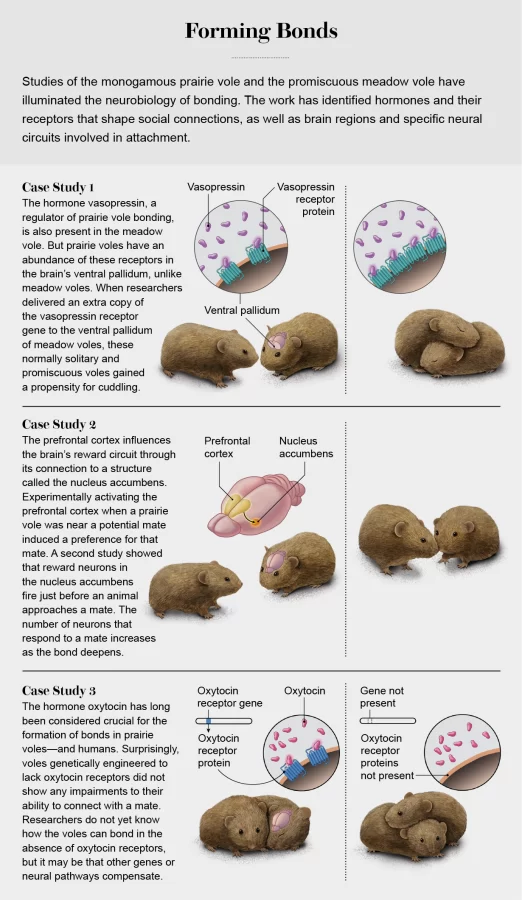What sits behind the thought of “Love”
When vole’s brains are Introduced to these chemicals they cause attractions to form
February 23, 2023
Since the dawn of time, love has been a mysterious and unexplainable phenomenon. This was because we couldn’t fully explain it. This led us to the once prairies of Illinois, to look at our little friends, the prairie vole. These mammals like some others are considered to be Monogamous. This means that they only mate with one other at a time. Humans are also considered to be Monogamous for the most part. This means that we can learn about ourselves by studying them. The study of the Prairie voles started because the same pairs of voles kept showing up in trap’s together. With this knowledge, we went into further study to learn more about why they stick together and what causes these bounds.
Oxytocin, which was long known as a regulator of birth, lactation, and maternal care, was essential to forming bonds. Along with this emerged vasopressin which is known to regulate blood pressure, blood osmolality, along with blood volume. These two chemicals were believed to be what caused bonding. To test this scientists delivered an extra copy of the vasopressin gene to the ventral pallidum of meadow voles. This caused the normally solitary and promiscuous voles to become prone to cuddling. Even though Vasopressin and Oxytocin are ubiquitous or seen in all animals they examined, many of them were not Monogamous. To explain how this works we have to look a little deeper. Vasopressin and oxytocin are peptides or more commonly known hormones. Hormones influence the functions of the body’s cells by attaching to large proteins known as receptors, whose shape and electrical charge interact with one particular hormone. After the hormone and protein bond, It causes a change in the shape of the receptor which triggers changes within the cell. Since these hormones are in many different species and only promote bonding in some species but not others it makes sense to say that the distribution of these hormones is not always the same. It was discovered that a close relative to the prairie vole and the pine vole, the meadow and montane voles also has an abundance of these receptors. Yet the receptors were in different regions of the brain than the prairie vole. In the monogamous voles, these receptors are seen in what is known as the brain’s reward circuit. Now, this is the area that neuroscientists have long studied in the context of drug abuse. In turn, causing love to be formally announced and considered an addiction.
In “Monogamous Prairie Voles Reveal the Neurobiology of Love” Steven Phelps, Zoe Donaldson, and Dev Manoli say, ‘ “We see that bonds rely on joining the specific cues associated with a potential partner to the feelings of desire. Reward prompts voles to stay close to each other, to huddle together. There are genes that stand ready to guide circuits toward learning the identity of a new partner, genes that seem to stabilize bonds and genes that oversee the experience of loss. To do so, they must, in ways we do not yet fully understand, harness the brain’s capacity for memory and emotion.” This gives us evidence that explains how love works for the most part and shows us there are other animals out there that use their brains in similar ways to us. Also showing us that we are not the only being on this planet that truly feels the sensation known as love.
This next part is dedicated to a scientific ideal, what is being said is not written with any negative intention towards the subject.
To connect this to the ways humans feel toward each other we need to talk about preferences. Nowadays it is seen quite commonly that there are people who like people of the same or both genders. Now there’s nothing wrong with this but there is a potential process that is occurring to cause this. In voles, we have seen that certain chemicals were released within the sectors of the brain that are associated with addiction which causes them to fall in love or become attracted to another vole. With straight people, it activates when they’re around a potential mate of the opposite gender. While for someone in the LGBTQ+ community, it activates when they are around someone of the same gender thus causing them to be attracted to that person of the same gender. Once again there’s nothing wrong with this, it is just a different way that the human brain is functioning. So overall there are many alterations in the ways people’s brains function that cause them to see people differently than others.


